Feedback Mechanism in Bifurcating River Systems: the Effect on Water-Level Sensitivity
Abstract
1. Introduction
2. Domain Description
2.1. Study Area
2.2. Available Bedform Measurements
3. Methodology
3.1. Deriving Roughness Scenarios from the Available Bedform Dimension Data
3.2. Sensitivity Analysis Using the Hydraulic SOBEK Model of the Rhine Branches
3.3. Obtaining Design Water Levels (DWLs) Using Model Averaging
4. Results
4.1. Sensitivity to Roughness in a Single-Branch River
4.2. Sensitivity to Roughness in a Bifurcating River System
4.3. Impact on Design Water Levels
5. Discussion
5.1. Roughness Scenarios
5.2. Uncertainty Analyses in Bifurcating River Systems
6. Conclusions
Author Contributions
Funding
Acknowledgments
Conflicts of Interest
References
- Dilley, M.; Chen, R.S.; Deichmann, U.; Lerner-Lam, A.L.; Arnold, M.; Agwe, J.; Buys, P.; Kjevstad, O.; Lyon, B.; Yetman, G. Natural Disaster Hotspots: A Global Risk Analysis; The World Bank: Washington, DC, USA, 2005. [Google Scholar]
- Bomers, A.; Schielen, R.M.J.; Hulscher, S.J.M.H. Consequences of dike breaches and dike overflow in a bifurcating river system. Nat. Hazards 2019, 97, 303–304. [Google Scholar] [CrossRef]
- Warmink, J.J.; Booij, M.J.; Van der Klis, H.; Hulscher, S.J.M.H. Quantification of uncertainty in design water levels due to uncertain bed form roughness in the Dutch river Waal. Hydrol. Process. 2013, 27, 1646–1663. [Google Scholar] [CrossRef]
- Apel, H.; Merz, B.; Thieken, A.H. Quantification of uncertainties in flood risk assessments. Int. J. River Basin. Manag. 2008, 6, 149–162. [Google Scholar] [CrossRef]
- Berends, K.B.; Straatsma, M.A.; Warmink, J.J.; Hulscher, S.J.M.H. Uncertainty quantification of flood mitigation predictions and implications for decision making. Nat. Hazard Earth Sys. 2019, 19, 1737–1753. [Google Scholar] [CrossRef]
- Pappenberger, F.; Beven, K.J. Ignorance is bliss: Or seven reasons not to use uncertainty analysis. Water Resour. Res. 2006, 42, W05302. [Google Scholar] [CrossRef]
- Pappenberger, F.; Beven, K.J.; Ratto, M.; Matgen, P. Multi-method global sensitivity analysis of flood inundation models. Adv. Water Resour. 2008, 31, 1–14. [Google Scholar] [CrossRef]
- Merz, B.; Thieken, A.H. Flood risk curves and uncertainty bounds. Nat. Hazards 2009, 51, 437–458. [Google Scholar] [CrossRef]
- Warmink, J.J.; Van der Klis, H.; Booij, M.J.; Hulscher, S.J.M.H. Identification and quantification of uncertainties in a hydrodynamic river model using expert opinions. Water Resour. Manag. 2011, 25, 601–622. [Google Scholar] [CrossRef][Green Version]
- Bozzi, S.; Passoni, G.; Bernardara, P.; Goutal, N.; Arnaud, A. Roughness and discharge uncertainty in 1D water level calculations. Environ. Model Assess. 2015, 20, 343–353. [Google Scholar] [CrossRef]
- Bomers, A.; Schielen, R.M.J.; Hulscher, S.J.M.H. Application of a lower-fidelity surrogate hydraulic model for historic flood reconstruction. Environ. Model Softw. 2019, 117, 223–236. [Google Scholar] [CrossRef]
- Van Vuren, B.G.; De Vriend, H.J.; Ouwerkerk, S.; Kok, M. Stochastic modelling of the impact of flood protection measures along the river Waal in the Netherlands. Nat. Hazards 2005, 36, 81–102. [Google Scholar] [CrossRef]
- Klijn, F.; Asselman, N.E.M.; Mosselman, E. Robust river systems: On assessing the sensitivity of embanked rivers to discharge uncertainties, exemplified for the Netherlands’ main rivers. J. Flood Risk Manag. 2018, 12, e12511. [Google Scholar] [CrossRef]
- Ardıçlıoğlu, M.; Alban Kuriqi, A. Calibration of channel roughness in intermittent rivers using HEC-RAS model: Case of Sarimsakli creek, Turkey. SN Appl. Sci. 2019, 1, 1080. [Google Scholar] [CrossRef]
- Van Rijn, L.C. Principles of Sediment Transport in Rivers Estuaries and Coastal Areas; Aqua Publications: Blokzijl, The Netherlands, 1993. [Google Scholar]
- Julien, P.Y.; Klaassen, G.J. Sand-dune geometry of large rivers during floods. J. Hydraul. Eng. 1995, 121, 657–663. [Google Scholar] [CrossRef]
- Best, J. The fluid dynamics of river dunes: A review and some future research directions. J. Geophys. Res. 2005, 110, F04S02. [Google Scholar] [CrossRef]
- Nelson, J.M.; Logan, B.L.; Kinzel, P.J.; Shimizu, Y.; Giri, S.; Shreve, R.L.; McLean, S.R. Bedform response to flow variability. Earth Surf. Process. Landf. 2011, 36, 1938–1947. [Google Scholar] [CrossRef]
- Hulscher, S.J.M.H.; Daggenvoorde, R.J.; Warmink, J.J.; Vermeer, K.; Van Duin, O. River dune dynamics in regulated rivers. In Proceedings of the 4th International Symposium on Shallow Flows, Eindhoven, The Netherlands, 26–28 June 2017. [Google Scholar]
- Berends, K.B.; Warmink, J.J.; Hulscher, S.J.M.H. Efficient uncertainty quantification for impact analysis of human interventions in rivers. Environ. Model Softw. 2018, 107, 50–58. [Google Scholar] [CrossRef]
- Jansen, P.P.; Van Bendegom, L.; Van den Berg, J.; De Vries, M.; Zanen, A. Principles of River Engineering: The Non-Tidal Alluvial River; Delftse Uitgevers Maatschappij: Delft, The Netherlands, 1979. [Google Scholar]
- Ciullo, A.; De Bruijn, K.M.; Kwakkel, J.H.; Klijn, F. Systematic flood risk management: The challenge of accounting for hydraulic interactions. Water 2019, 11, 2530. [Google Scholar] [CrossRef]
- Reeze, B.; Van Winden, A.; Postma, J.; Pot, R.; Hop, J.; Liefveld, W. Watersysteemrapportage Rijntakken 1990–2015; Ontwikkelingen Waterkwaliteit en Ecologie; Bart Reeze Water & Ecologie: Harderwijk, The Netherlands, 2017. [Google Scholar]
- Brilhuis, R. Enkele Hydraulische en Morfologische Parameters van de Nederlandse Rijntakken; Rijkswaterstaat: Arnhem, The Netherlands, 1988. [Google Scholar]
- Wilbers, A.W.E.; Ten Brinke, W.B.M. The response of sub-aqueous dunes to floods in sand and gravel bed reaches of the Dutch Rhine. Sedimentology 2003, 50, 1013–1034. [Google Scholar] [CrossRef]
- Frings, R.M.; Kleinhans, M.G. Complex variations in sediment transport at three large river bifurcations during discharge waves in the river Rhine. Sedimentology 2018, 55, 1145–1171. [Google Scholar] [CrossRef]
- Sieben, J. Taal van de Rivierbodem; Rijkswaterstaat: Lelystad, The Netherlands, 2008. [Google Scholar]
- Vanoni, V.A.; Hwang, L.S. Relation between bedforms and friction in streams. J. Hydraul. Div. 1967, 93, 121–144. [Google Scholar]
- Julien, P.Y.; Klaassen, G.J.; Ten Brinke, W.B.M.; Wilbers, A.W.E. Case study: Bed resistance of Rhine river during 1998 flood. J. Hydraul. Eng. 2002, 128, 1042–1050. [Google Scholar] [CrossRef]
- Paarlberg, A.J.; Dohmen-Jansen, C.M.; Hulscher, S.J.M.H.; Termes, A.P.P.; Schielen, R.M.J. Modelling the effect of time-dependent river dune evolution on bed roughness and stage. Earth Surf. Process. Landf. 2010, 35, 1854–1866. [Google Scholar] [CrossRef]
- Deltares. SOBEK3, D-Flow 1D User Manual Version 3.4.0; Deltares: Delft, The Netherlands, 2020. [Google Scholar]
- Becker, A.; Scholten, M.; Kerkhoven, D.; Spruyt, A. Das behördliche Modellinstrumentarium der Niederlande. In Dresdner Wasserbaukolloquium 2014 Simulationsverfahren und Modelle für Wasserbau und Wasserwirtschaft; Stamm, J., Ed.; Dresden University of Technology: Dresden, Germany, 2014; pp. 539–548. [Google Scholar]
- Straatsma, M.W.; Huthoff, F. Uncertainty in 2D hydrodynamic models from errors in roughness parameterization based on aerial images. J. Phys. Chem. Earth 2011, 36, 324–334. [Google Scholar] [CrossRef]
- Parrish, M.A.; Moradkhani, H.; DeChant, C.M. Toward reduction of model uncertainty: Integration of Bayesian model averaging and data assimilation. Water Resour. Res. 2012, 48, W03519. [Google Scholar] [CrossRef]
- Liu, Z.; Merwade, V. Accounting for model structure, parameter and input forcing uncertainty in flood inundation modeling using Bayesian model averaging. J. Hydr. 2018, 565, 138–149. [Google Scholar] [CrossRef]
- Diermanse, F.L.M. Overzichtsrapport Onzekerheden: Overzicht van Belasting- en Sterkte-Onzekerheden in Het Wettelijk Beoordelingsinstrumentarium; Deltares: Delft, The Netherlands, 2017. [Google Scholar]
- Prinsen, G.; Van den Boogaard, H.; Hegnauer, M. Onzekerheidsanalyse Hydraulica in GRADE; Deltares: Delft, The Netherlands, 2015. [Google Scholar]
- De Ruijscher, T.V.; Naqshband, S.; Hoitink, A.J.F. Effect of non-migrating bars on dune dynamics in a lowland river. Earth Surf. Proc. Landf. 2020, 45, 1361–1375. [Google Scholar] [CrossRef]
- Naqshband, S.; Ribberink, J.S.; Hulscher, S.J.M.H. Using both free surface effect and sediment transport mode parameters in defining the morphology of river dunes and their evolution to upper stage plane beds. J. Hydraul. Eng. 2014, 140, 1–6. [Google Scholar] [CrossRef]
- Warmink, J.J. Dune dynamics and roughness under gradually varying flood waves, comparing flume and field observations. Adv. Geosci. 2014, 39, 115–121. [Google Scholar] [CrossRef][Green Version]
- Kleinhans, M.G.; Jagers, H.R.A.; Mosselman, E.; Sloff, C.J. Bifuration dynamics and avulsion duration in meandering rivers by one-dimensional and three-dimensional models. Water Resour. Res. 2008, 44, W08454. [Google Scholar] [CrossRef]

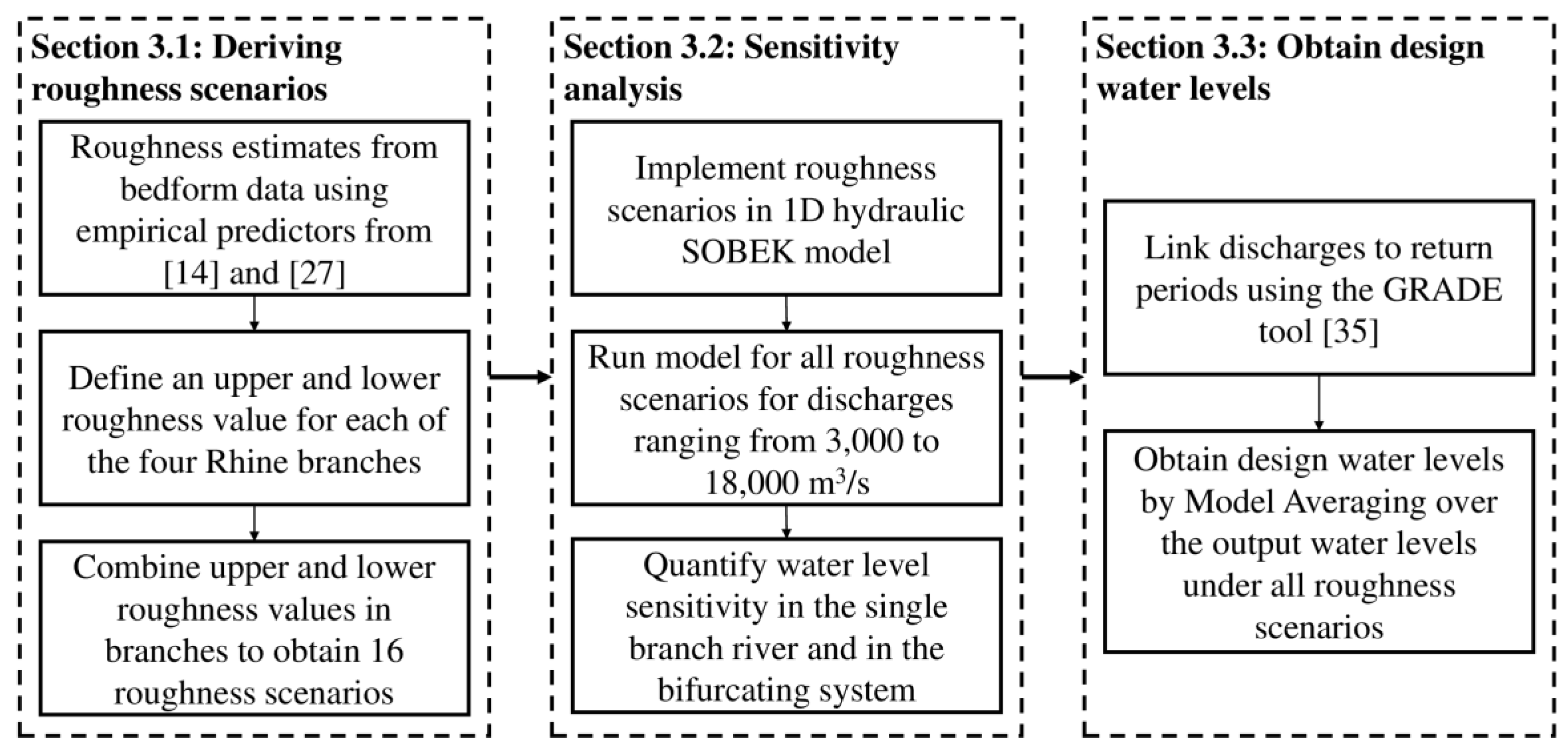


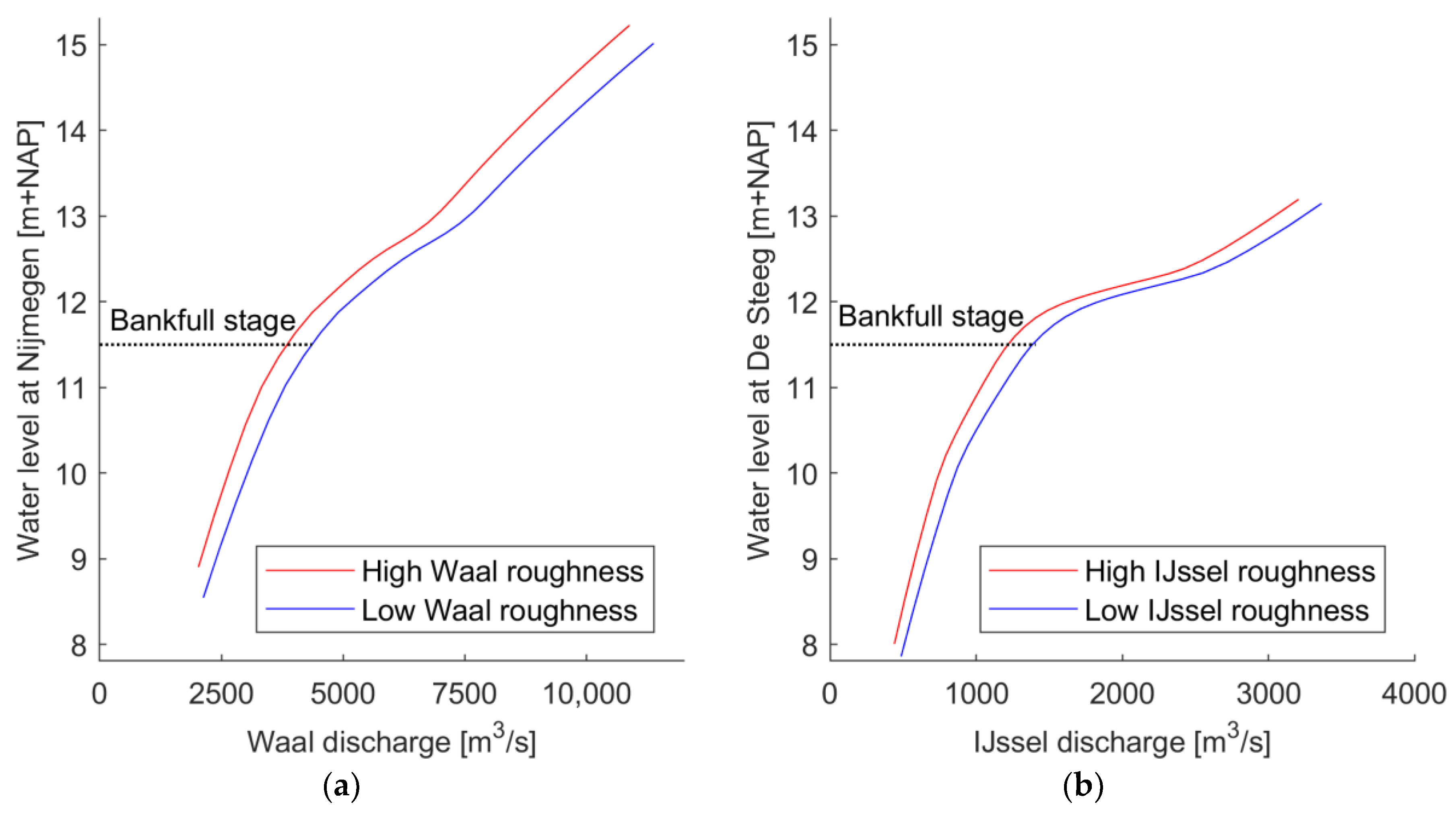

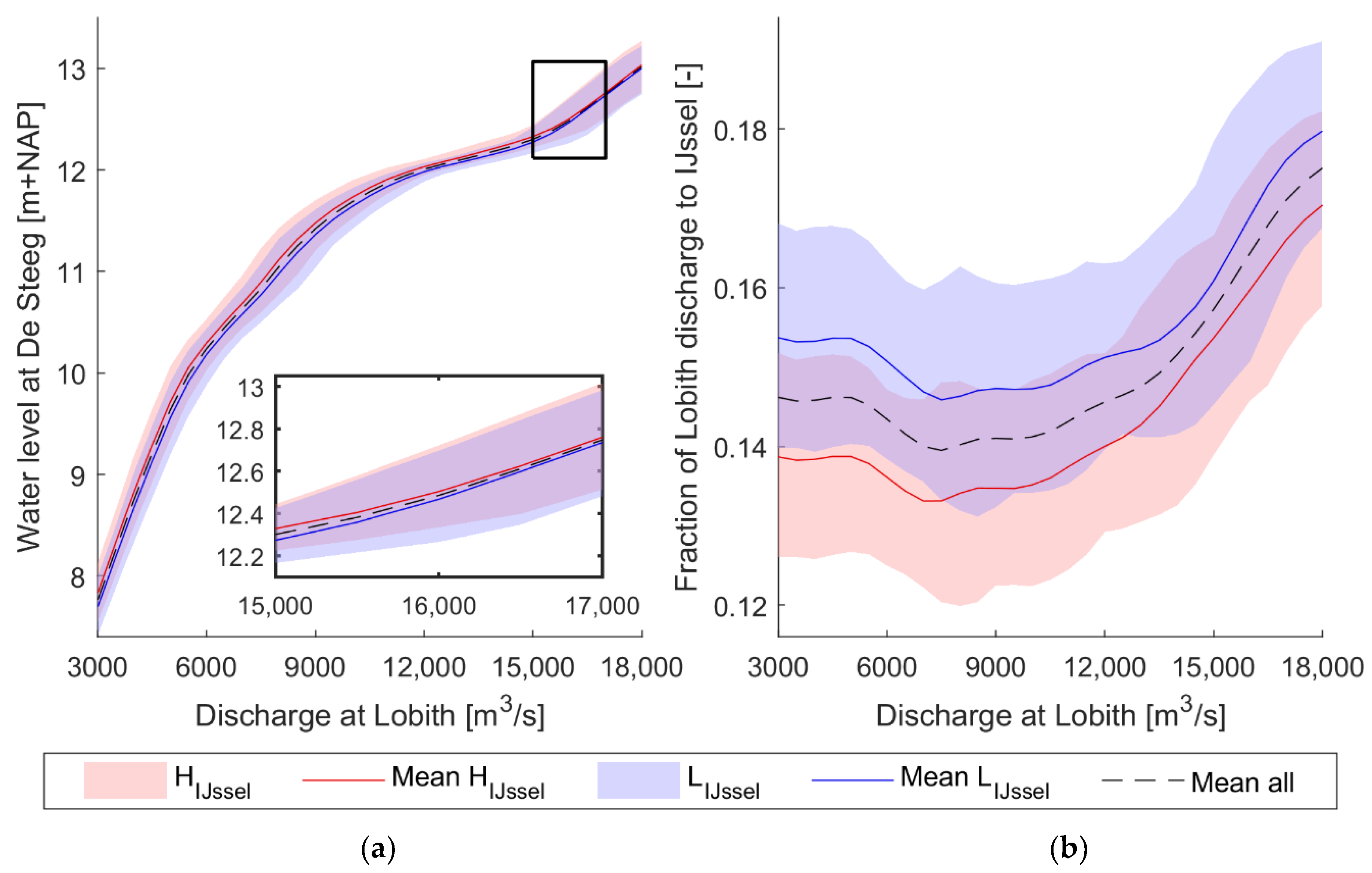

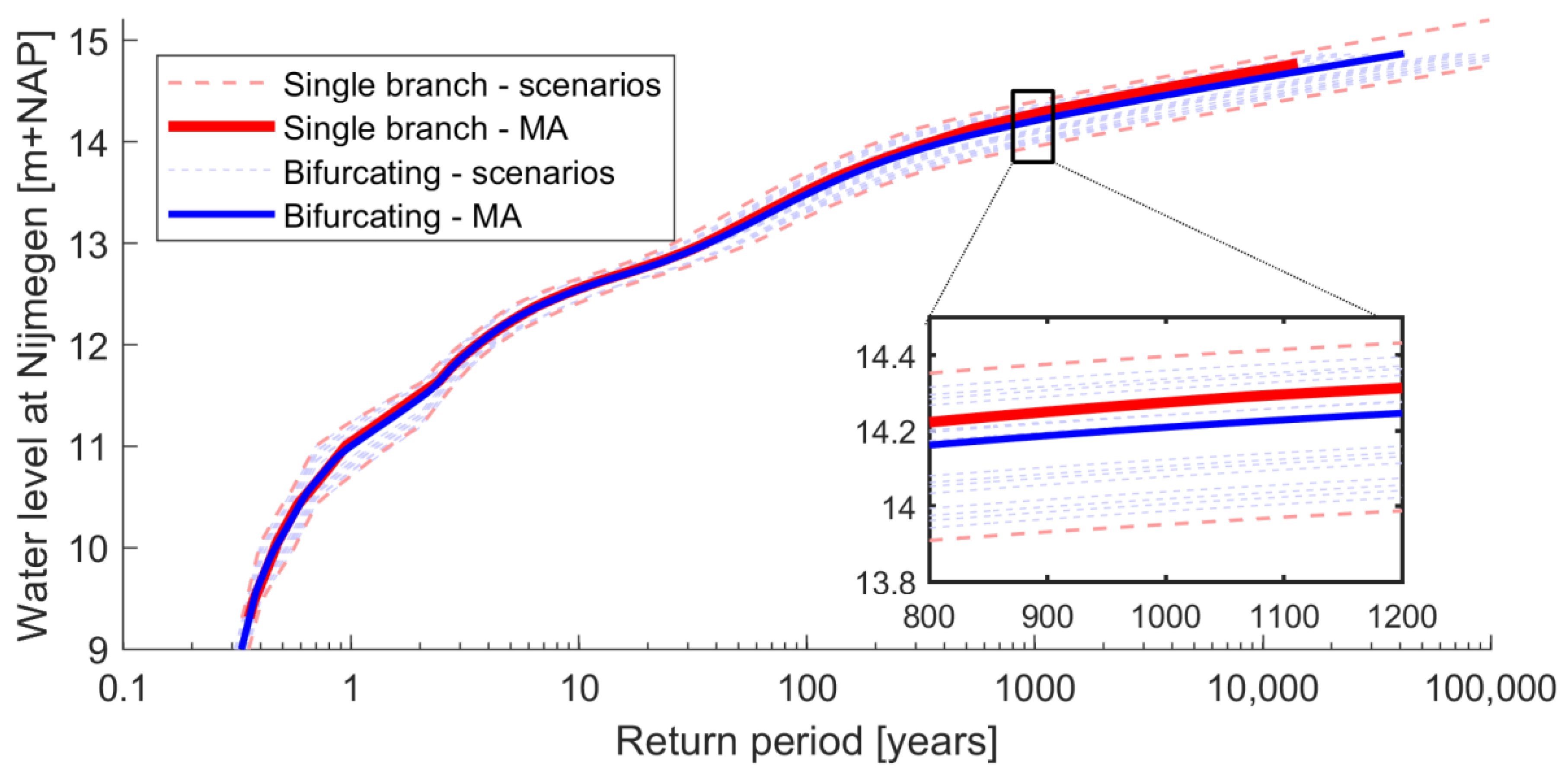
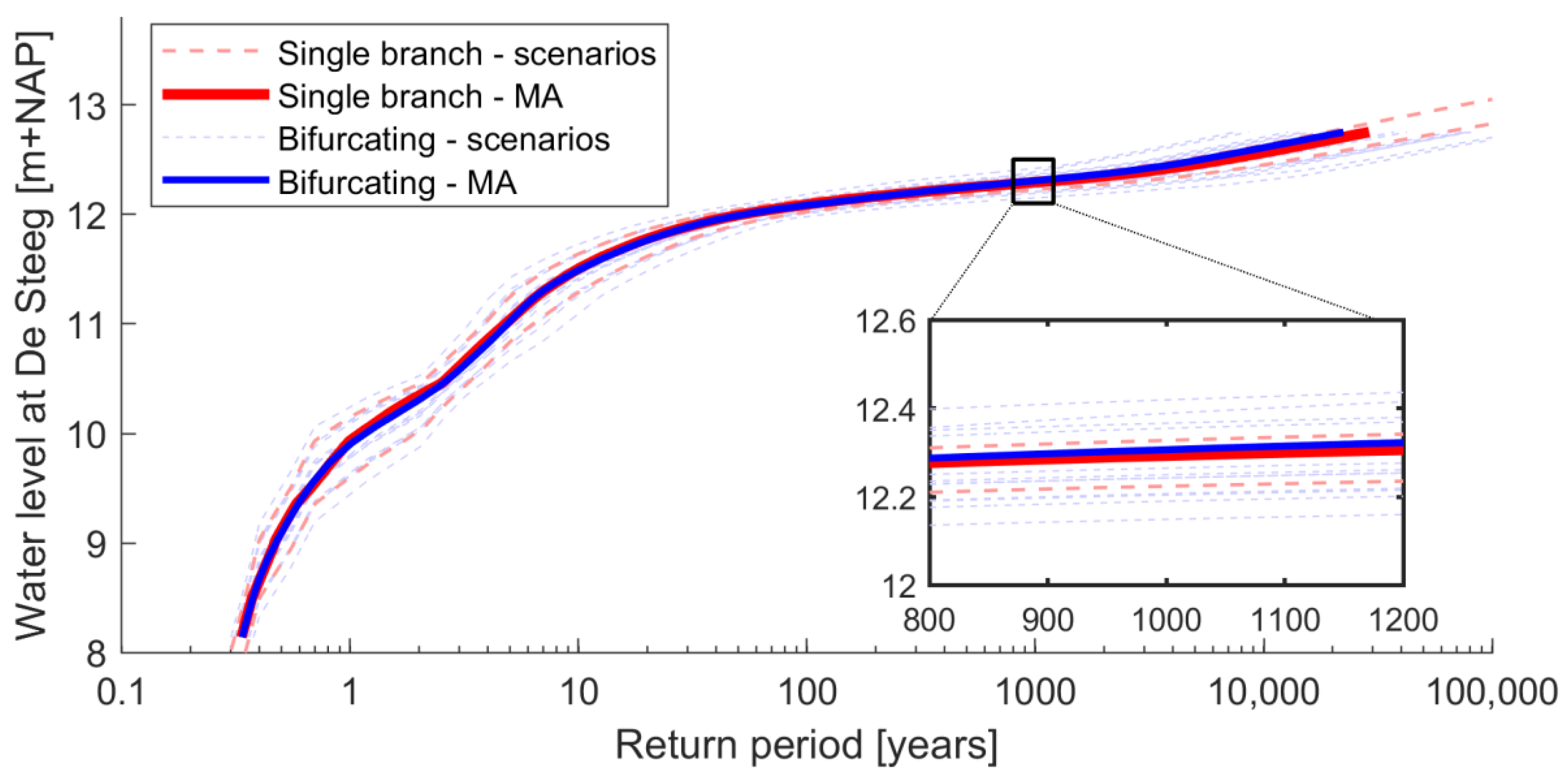

| River Branch | Bankfull Discharge (m3/s) | Width Main Channel (m) | Mean Width Floodplains (m) | Median Grain Size (D50) (mm) |
|---|---|---|---|---|
| Dutch Upper Rhine | 5000 | 330–440 | 850 | 3–4 |
| Waal | 3400 | 260–370 | 550 | 1–2 |
| Pannerdensch Kanaal | 1600 | 130–200 | 400 | 3–5 |
| Nederrijn | 900 | 130–200 | 400 | 1–2 |
| IJssel | 700 | 80–120 | 500 | 2–5 |
| Source | # Data Points | Location | Period | Flow Regime (s) |
|---|---|---|---|---|
| [25] | 38 | WA1 | 1997–1998 | Flood waves ’97 and ‘98 |
| [25] | 84 | WA2a | 1989–1998 | Moderate flows & flood waves ’95, ’97 and ‘98 |
| [25] | 49 | WA2b | 1994–1998 | Flood waves ’95, ’97 and ‘98 |
| [25] | 31 | PK1 | 1997–1998 | Flood waves ’97 and ‘98 |
| [27] | 94 | WA3 | 2002–2003 | Moderate flows |
| [26] | 5 | PK2 | Jan. 2004 | Moderate flows |
| [26] | 5 | IJ | Jan. 2004 | Moderate flows |
| ΔDWL (Bif.–Single) | Nijmegen (Waal) | De Steeg (IJssel) | Driel (Nederrijn) |
|---|---|---|---|
| T = 100 years | −3 cm | −1 cm | +1 cm |
| T = 1000 years | −6 cm | +1 cm | −2 cm |
| T = 10,000 years | −8 cm | +5 cm | −1 cm |
© 2020 by the authors. Licensee MDPI, Basel, Switzerland. This article is an open access article distributed under the terms and conditions of the Creative Commons Attribution (CC BY) license (http://creativecommons.org/licenses/by/4.0/).
Share and Cite
Gensen, M.R.A.; Warmink, J.J.; Huthoff, F.; Hulscher, S.J.M.H. Feedback Mechanism in Bifurcating River Systems: the Effect on Water-Level Sensitivity. Water 2020, 12, 1915. https://doi.org/10.3390/w12071915
Gensen MRA, Warmink JJ, Huthoff F, Hulscher SJMH. Feedback Mechanism in Bifurcating River Systems: the Effect on Water-Level Sensitivity. Water. 2020; 12(7):1915. https://doi.org/10.3390/w12071915
Chicago/Turabian StyleGensen, Matthijs R.A., Jord J. Warmink, Fredrik Huthoff, and Suzanne J.M.H. Hulscher. 2020. "Feedback Mechanism in Bifurcating River Systems: the Effect on Water-Level Sensitivity" Water 12, no. 7: 1915. https://doi.org/10.3390/w12071915
APA StyleGensen, M. R. A., Warmink, J. J., Huthoff, F., & Hulscher, S. J. M. H. (2020). Feedback Mechanism in Bifurcating River Systems: the Effect on Water-Level Sensitivity. Water, 12(7), 1915. https://doi.org/10.3390/w12071915







